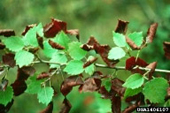Blog
Bronze Leaf Disease
Protect Your Poplars from Fungal Attacks
 Bronze leaf disease (BLD) is a fungus that infects various poplar species and hybrids; specifically trembling aspen, Swedish columnar aspen and tower poplar. BLD is relatively new to Calgary and can kill an infected tree within three to five years of initial infection.
Bronze leaf disease (BLD) is a fungus that infects various poplar species and hybrids; specifically trembling aspen, Swedish columnar aspen and tower poplar. BLD is relatively new to Calgary and can kill an infected tree within three to five years of initial infection.
Early detection and treatment is important. There are currently no known chemical controls for BLD. Taking preventative actions and understanding treatment options can save trees and mitigate the risk of widespread infection.
Symptoms
- Diseased leaves often first show up in the lower crown, but may be scattered throughout the crown of the tree or isolated to a few branches.
- Leaves become dark reddish-brown, chocolate brown or bronze although the veins and the leaf stem may remain green for some time.
- Infected leaves remain on the tree through winter.
- Once the disease spreads, browning may be observed under the bark of diseased branches.
- New leaves on infected branches may appear underdeveloped in subsequent years.
How Does BLD Spread?
- BLD spreads from one tree to the next via airborne spores.
- Spore dispersal occurs in early spring, once daily temperatures average 18 degrees Celsius.
If I Know My Tree Has BLD, What Can I Do?
- Prune off infected branches. Collect materials from diseased trees and take to a City landfill. Do not compost, chip or use this material for firewood.
- Prune diseased branches eight to 12 inches below visible sign of infection.
- When removing diseased material, be careful to clean up thoroughly and dispose of debris.
Tree tip: Regular maintenance and tree care equip your tree to resist disease and fight infections. Routine tree care goes a long way to ensuring good tree health.
How Do I Report a Confirmed Case of BLD?
Phone 3-1-1 or 403-268-CITY (2489) if calling from outside Calgary, or complete the 3-1-1 Online Contact Form, or contact ArborCare Tree Service Ltd. at 403-273-6378. Call us toll-free at 1-800-645-6533.
Collaboration between the city, citizens and tree care professionals is required to make sure BLD does not become widespread. Parks officials want to know about ALL confirmed cases of BLD in privately owned trees.
Please help us understand the scope of BLD in Calgary and help keep Calgary’s urban forest healthy. Report ANY confirmed case(s) of BLD to the city.
How Can I Be Sure My Tree Has BLD?
Below are the typical symptoms of BLD during all four seasons. This information is for reference only. If your tree displays any of these symptoms, it may be infected, and you should contact your local tree care professional for diagnoses and treatment information.
Winter
Leaves will remain on an infected tree and will be brown/bronze in colour.
Spring
Already infected branches may grow new, stunted leaves. These leaves may appear underdeveloped but their colour will look normal (green).
Summer
An infected tree will produce regular size, healthy green leaves that will become infected by spores from previously infected leaves on the same tree.
After it becomes infected, the stem and leaf veins of the regular size leaves will remain green while the rest of the leaf progressively turns brown or bronze. Eventually, the infected leaf will turn colour.
Fall
A localized infection will be evident. The tree will display a combination of both healthy and infected branches.
Healthy leaves will fall, and infected leaves will remain on the tree.
Note: the colour of infected leaves varies from very bronze to chocolate brown to dull brown.
Source: City of Calgary

